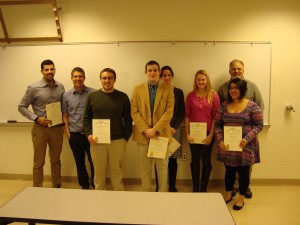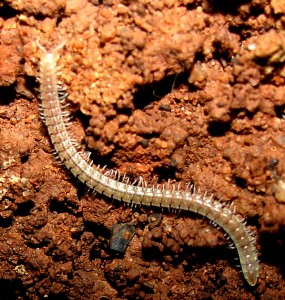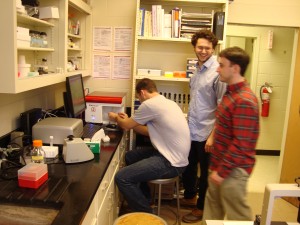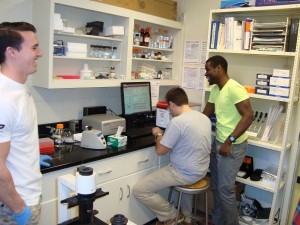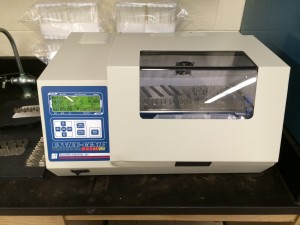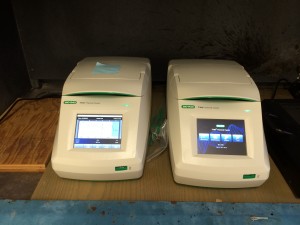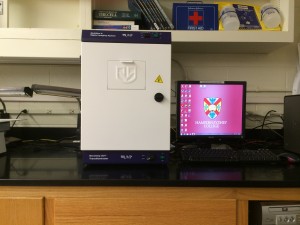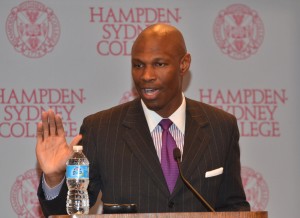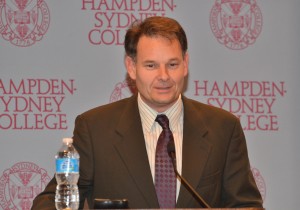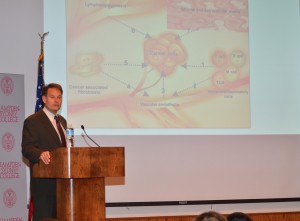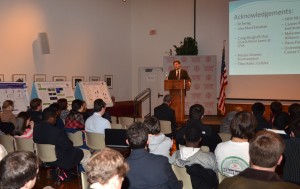On Tuesday, March 18, five H-SC students and two H-SC Biology professors were inducted into the Longwood University/Hampden-Sydney College Chapter of Sigma Xi, the international honorary Scientific Research Society! These new members were recognized for their excellence in scientific research and their ongoing commitment to foster collaboration and communication among the scientific community. The new initiates pictured below from left to right are: Giovanni Torres ’14, Dr. Ed Lowry, Christian Lehman ’14, Lee Ayscue ’15, Dr. Rachel Goodman, Emily Whitman (Longwood University), Heaven Cerritos (Longwood University), and Dr. Dale Beach (Longwood University). Not pictured are John Dekarske ’14 and Dane Asuigui ’16. Congratulations to our newest members of Sigma Xi!
Category Archives: Uncategorized
Spring Break in the Okefenokee Swamp
Dr. Shear took a four-day trip over spring break to collect millipedes for his MITS grant research in southeast Georgia. Included in visits were the Okefenokee and Cumberland Island Wildlife Refuges and Crooked River State Park. Canoeing through the Okefenokee for six hours resulted in observations of many birds, such as wood storks, egrets and herons, and abundant sightings of alligators basking on the mudflats. An unusual habitat at Crooked River is the Maritime Deciduous Forest, isolated here by wide expanses of Longleaf Pine Forest. The MDF, very likely a primary forest at this site, consists of live oak, hickory and cherry, with an understory of holly, turkey oak and buckeye. The trees were immense, the largest hickories we have ever seen. The forest grows on a huge shell midden–a pile of oyster shells that accumulated over the 4000-year-long occupation of the island by the Timucua tribe. On Cumberland Island, the Maritime Forest has a different expression, consisting almost entirely of live oak, but dwarfed by the constant winds from the sea and salt spray. The trees are only about 20-30 feet tall but their interlocking horizontal branches spread out more than twice that. In both forests, the litter layer is very sparse due to the rapid biological turnover in this warm climate, consisting of just a skim of leathery live oak leaves over sandy, black, organic-rich soil.
Not a particularly good habitat for millipedes, but two rare species were collected and preserved for transcriptome and DNA-barcoding work: Stelgipus serratus and Dicellarius okefenokensis. Both have very narrow distributions centering on SE Georgia and adjacent Florida.
Cooperation with Brazilian ecologists reveals “missing link” in millipede evolution
Image
Cooperating with ecologists at the Universidad Federal de Lavras in Brazil, Dr. Shear is working on a description of a “missing link” species of millipede. We’re calling it such because it potentially combines the characters of two quite different groups of millipedes previously thought to be unrelated. The new species belongs to the Order Polydesmida, but has nearly twice as many body segments as other members of that order. Specimens of the millipede were recovered from an unusual habitat, an iron-ore cave. Most caves are found in limestone or marble, or result from “lava tubes” in volcanic areas, but these unique Brazilian caves have resulted from the erosion of iron ore deposits. The millipedes may have occupied the caves for millions of years, and are white and eyeless as a result.
H-SC Immunology Students Use New Flow Cytometer to Study Dendritic Cell Maturation!
Students in Dr. Kristian M. Hargadon’s Biology 323 – Immunology class recently began utilizing the Biology Department’s new flow cytometer in their laboratory projects. Flow cytometry is a powerful fluorescence-based detection system with numerous applications that include immunophenotyping, cytolysis assays, cell cycle analyses, gene expression studies, cellular proliferation assays, etc. (just to name a few!). Students enrolled in Immunology this semester are using this cutting-edge technology to study the maturation of dendritic cells in response to several stimuli. Dendritic cells are key regulators of host immune responses, and their maturation is critical to the effective induction of immunity to foreign pathogens and tumors. In previous weeks, students have isolated dendritic cells from the spleens of mice and cultured these cells with various maturation stimuli, including Toll-like receptor ligands and CD40L, either alone or in combination. Just this week, these students utilized flow cytometry to measure the cell surface expression of two important immune stimulatory proteins, CD80 and CD86, that are upregulated on dendritic cells during their maturation. Using this approach, students were able to analyze the expression of these molecules on tens to hundreds of thousands of cells in less than 1 minute! The H-SC Biology Department is so excited about training our students to utilize this technology, and we will be incorporating flow cytometry into several of the Department’s laboratory course offerings!
Biology department receives several equipment upgrades
The arrival of 2014 has seen the arrival of several new pieces of equipment in the Biology department that will enhance both classroom and research activity. The new equipment is the result of ~$17,000 in total external funds awarded to the department from the National Science Foundation and the Genome Consortium for Active Teaching (GCAT). First, the Enviro-Genie provides a controlled environment for heating, cooling, and incubating biological reagents:
Next, the Department has obtained a second PCR machine for the specific amplification of DNA segments of interest:
Finally, the Department now has a sophisticated method to document gels from DNA and RNA based experiments:
The new equipment lets the faculty in the Department integrate new and exciting experiments into their classes as well as their individual research projects.
Dr. Rachel Goodman receives grant renewal
Dr. Rachel Goodman recently received a grant renewal from the Thomas F. and Kate Miller Jeffress Memorial Trust. Her research explores interactions between ranavirus, an emerging wildlife disease, and chemical pollutants using a model system in reptiles. An experiment in summer 2014 will examine how juvenile red-eared slider turtles respond to ranavirus in the presence of commonly used herbicides.
Dr. Kristian M. Hargadon ’01 Receives Renewal of Grant for Cancer Research
Elliott Assistant Professor of Biology Dr. Kristian M. Hargadon ’01 received a $10,000 renewal of a Virginia Academy of Science Jeffress Research Grant from the Thomas F. Jeffress and Kate Miller Jeffress Memorial Trust for his project entitled “Tumor-induced Immunosuppression of Dendritic Cell Function.” This renewal brings total funding from the Jeffress Trust for this project to $45,000 over the last 3 years. With the previous funding, Dr. Hargadon has utilized this funding to study the mechanism of melanoma associated suppression of the function of dendritic cells, immune cells that are critical regulators of overall anti-tumor immune responses. Using both in vitro and ex vivo model systems, Dr. Hargadon and collaborating H-SC students have identified partial roles for the melanoma-derived factors TGFbeta1 and VEGF-A in the suppression of dendritic cell function. This new funding will be used to further characterize the nature of melanoma-altered dendritic cells and to evaluate how these altered dendritic cells impact the quality of helper and cytotoxic T cell activation and differentiation. Together, these and the previous studies from this project will provide insights into tumor immune evasion strategies and may inform the design of novel immunotherapies for the treatment of melanoma.
Dr. Kristian M. Hargadon ’01 Featured in Global Medical Discovery
Elliott Assistant Professor of Biology Dr. Kristian M. Hargadon’s recent article entitled “Tumor-Altered Dendritic Cell Function: Implications for Anti-Tumor Immunity,” which was published in the summer of 2013 in the journal Frontiers in Immunology, has recently been featured in the Global Medical Discovery Series. Global Medical Discovery is an online platform founded in 2002 that is designed “to highlight breaking news about the latest scientific discoveries” and “to promote the status of talented scientists and industry experts in the international academic and pharmaceutical industry scene.” Dr. Hargadon’s article focuses on recent advances in tumor immunology that have increased our understanding of anti-tumor immune dysfunction, and it emphasizes immunotherapeutic strategies that have been designed to overcome this dysfunction while also highlighting questions that remain to be addressed in this field to further optimize anti-tumor immune responses and improve cancer treatment.
The featured article can be found at: http://globalmedicaldiscovery.com/key-scientific-articles/tumor-altered-dendritic-cell-function-implications-anti-tumor-immunity/
Sigma Xi Research Day Symposium Kicks Off Re-activation of Scientific Research Society Chapter at H-SC
Sigma Xi, the international multidisciplinary scientific research society, was founded in 1886 to honor excellence in scientific investigation and encourage collaboration among researchers in all fields of science and engineering. The Society consists of over 500 chapters at academic, industrial, and government research institutions and has nearly 60,000 members in more than 100 countries around the world. The Society endeavors to encourage support of original work across the spectrum of science and technology and to promote an appreciation within society at large for the role research has played in human progress.
In 2013 Hampden-Sydney College and Longwood University reactivated their long-dormant joint chapter of Sigma Xi in an effort to promote scientific research achievements by students and faculty and to foster collaboration between the two institutions. Chapter reactivation began over the summer of 2013 with a drafting of by-laws for the joint Sigma Xi chapter, and the schools celebrated their newly activated status on November 12, 2013 when Hampden-Sydney College hosted the inaugural Longwood University/Hampden-Sydney College Sigma Xi Research Day Symposium. The event attracted nearly 100 students, faculty, and community members to Crawley Forum and began with a welcome by Dr. Kristian Hargadon ’01, Elliott Assistant Professor of Biology at H-SC and President of the Longwood/H-SC Sigma Xi chapter (Dr. Hargadon was first inducted into Sigma Xi while a student at Hampden-Sydney in 2000). He introduced Hampden-Sydney College President Dr. Christopher Howard, who delivered opening remarks for the symposium.
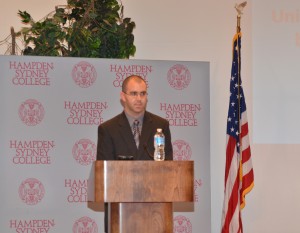
Dr. Kristian M. Hargadon ’01, President of the Longwood University/Hampden-Sydney College Sigma Xi Chapter
Following these opening remarks, keynote speaker Dr. Timothy Bullock, Associate Professor of Pathology and Microbiology in the Beirne B. Carter Center for Immunology Research and Human Immune Therapy Center at the University of Virginia, delivered his address entitled “United We Stand: Synergy Between Conventional and Immune-based Therapies for Cancer Treatment.” This energetic talk highlighted cutting edge strategies for combining chemotherapy and immunotherapy in the treatment of melanoma and other cancers. While these approaches were once thought to be at odds with one another (immune therapies promote replication of a patient’s immune cells, while chemotherapy attacks cancerous and non-cancerous cells undergoing replication), recent evidence now suggests that optimizing the delivery of these different therapies may lead to enhanced anti-tumor activity. That is, certain chemotherapies have been shown to induce a specialized type of tumor cell death that triggers immune cell stimulation, and subsequent administration of immune-based therapies may lead not only to further eradication of tumor cells that escaped chemotherapeutic destruction but also to long-lasting immune protection from tumor recurrence.
The keynote address was followed by a poster session in which Hampden-Sydney College and Longwood University students presented research conducted through Honors/Independent Study Projects and Summer Research Programs. The work of 22 students ranging from freshmen to seniors was showcased at the event and represented work conducted in various fields of science, including biology, chemistry, and physics.
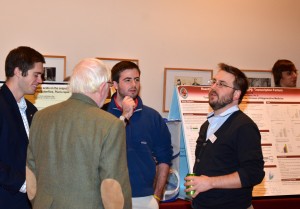
Jefferson Thompson and James Hughes discussing their research with Chemistry Professors Dr. Sipe and Dr. Deifel
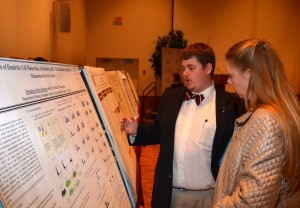
Drake Bishop presenting his cancer research to Longwood University tumor immunologist, Dr. Amorette Barber
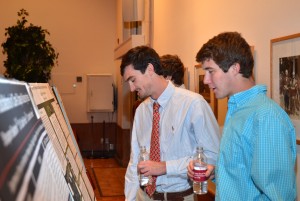
Davis Carter and Erik Kellogg discussing their research on Ranavirus infection in local herpetofauna and invasive plant species
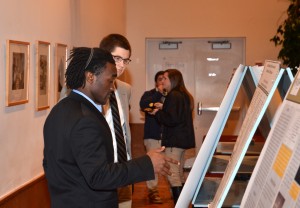
Biology major David Coe presenting his research on antibiotic resistance of ocular bacterial pathogens to Chemistry major John Dekarske
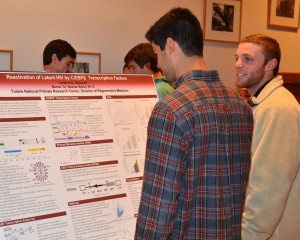
Biology major Carter Guice’s poster (Carter not shown), showing his summer research on HIV conducted at Louisiana State University
We are so excited by the enthusiasm for scientific research at Hampden-Sydney College and Longwood University generated by this symposium, and our newly reactivated Sigma Xi chapter has significant momentum moving forward. To follow up on the success of the symposium, an initiation ceremony will be held in Spring 2014 for the induction of new student and faculty members to the Society.
Whales and more
Here is a quick update on my marine mammal research in the Pacific Northwest, and a plea from an old biologist for students and others to be holistic in their approach… I have been spending my time in various ways, including: 1) looking through a stereomicroscope at collagen and other connective tissue fibers (in the baleen filter and associated gums of whales); 2) planning and preparing for electron microscopy of whales’ oral tissues to reveal microscopic wear patterns from water flow; 3) dissecting whole marine mammals (harbor porpoises, Pacific white-sided dolphins, and a sea otter) in necropsy sessions; and 4) looking at live marine mammals ranging from porpoises, dolphins, and whales (beluga, killer, humpback) to seals, sea lions, fur seals, and sea otters. Which is best? All of the above, naturally!
It is crucially important for biologists who study tiny levels of biological organization (molecules and cells) to know something about the ecology, behavior, and life history of the whole organisms these parts come from, even if those organisms are unicellular bacteria or yeasts. At the same time, biologists who work at the community and ecosystem level obviously need to know about the tissues and biochemical/physiological reactions that occur inside various organisms. Not surprisingly, the best understanding comes when you view life from all sides of this prism: that is, from both ends of this scale range and many points in between.
The great thing about biology at Hampden-Sydney is that our students and faculty—and our curriculum—ensure a focus on all levels of biological organization. Premedical students occasionally complain about having to study ecology, but it is essential for physicians to know about public health concerns from a population perspective, just as it is important for wildlife biologists to understand the molecular and genetic basis of life in whales, snakes, millipedes, and weeds. As I spend time at a huge (60,000 student) university where everyone—student and professor alike—is too often focused on a single tiny aspect of biology, it’s important to remember what a small institution like H-SC can offer, and indeed do better than a mighty, massive university. To put it another way—as one who daily spends time this autumn in an enormous (coastal temperate rain) forest—it is truly important “to see the forest for the trees.”

